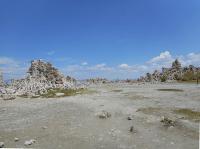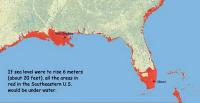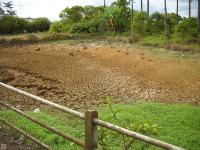-
Snowpack of Sierra Nevada lowest in 500 years, worsening California water woes

Snowpack in California’s Sierra Nevada in 2015 was at the lowest level in the past 500 years, according to a new report. “Our study really points to the extreme character of the 2014-15 winter. This is not just unprecedented over 80 years — it’s unprecedented over 500 years,” said the lead author of the report. On 1 April of this year, California Governor Jerry Brown declared the first-ever mandatory water restrictions throughout the state while standing on dry ground at 6,800-foot elevation in the Sierra Nevada. The historical average snowpack on that site is more than five feet, according to the California Department of Water Resources.
-
-
Engineers design invisibility cloak for military drones
Inspired by the well-known Invisibility Cloak from Harry Potter, electrical engineers have created a new design for their cloaking device, using a Teflon substrate, studded with cylinders of ceramic, which is thinner than any prior development and does not alter the brightness of light around concealed objects. The Teflon has a low refractive index, while the ceramic’s refractive index is higher, which allows light to be dispersed through the sheet without any absorption. Compared to an invisibility cloak, this technology has not only the ability to conceal, but the ability to increase optical communication signal speed and to collect solar energy.
-
-
Insider threats, organizational rigidity pose challenges for U.S. national security: Study
U.S. national security faces rising challenges from insider threats and organizational rigidity, a Stanford professor says. A new study says that in the past five years, seemingly trustworthy U.S. military and intelligence insiders have been responsible for a number of national security incidents, including the WikiLeaks publications and the 2009 attack at Fort Hood in Texas that killed 13 and injured more than 30. The study’s author acknowledges the difficulties of learning lessons from tragedies like 9/11, the NASA space shuttle accidents, and the 2009 Fort Hood shooting. She notes that policymakers tend to attribute failure to people and policies. While seemingly hidden at times, the organizational roots of disaster are much more important than many think, she added.
-
-
NOAA: El Niño may accelerate nuisance flooding
Nuisance flooding causes public inconveniences such as frequent road closures, overwhelmed storm water systems, and compromised infrastructure. The extent of nuisance flooding depends on multiple factors, including topography and land cover. According to a new NOAA report issued yesterday, many mid-Atlantic and West Coast communities could see the highest number of nuisance flooding days on record through April due to higher sea levels and more frequent storm surge, compounded by the strengthening El Niño, which is likely to continue into the spring. These communities may experience a 33 to 125 percent increase in the number of nuisance flooding days, the report said.
-
-
Army Corps of Engineers risk reduction projects prevent $13.3 billion in flood damages
May 2015 was the wettest month on record for both Texas and Oklahoma, and set numerous records throughout the region. Continuing rains from Tropical Storm Bill in June resulted in Army Corps of Engineers flood risk reduction reservoirs and other systems put through a rigorous test to hold the floodwaters and protect local communities and downstream areas. According to recent calculations by U.S. Army Corps of Engineers officials with the Southwestern Division in Dallas, the Corps flood risk reduction projects in the south central and southwestern United States prevented an estimated $13.3 billion in damages to local communities and infrastructure during the May-June 2015 flood event.
-
-
New personality profiling technique helps identify potential school shooters
Researchers from Ben-Gurion University of the Negev (BGU) have developed a personality profiling technique which automates the identification of potential school shooters by analyzing personality traits that appear in their writings. The text-based computational personality-profiling tool uses “vector semantics.” This involves constructing a number of vectors representing personality dimensions and disorders, which are analyzed automatically by computer to measure the similarity with texts written by the human subject.
-
-
2015 drought costs for California agriculture: Loss of $1.84 billion, 10,100 jobs

The drought is tightening its grip on California agriculture, squeezing about 30 percent more workers and cropland out of production than in 2014, according to the latest drought impact report. In 2015, the state’s agricultural economy will lose about $1.84 billion and 10,100 seasonal jobs because of the drought, the report estimated, with the Central Valley hardest hit. The heavy reliance on groundwater comes at ever-increasing energy costs as farmers pump deeper and drill more wells. Some of the heavy pumping is in basins already in severe overdraft — where groundwater use greatly exceeds replenishment of aquifers — inviting further land subsidence, water quality problems, and diminishing reserves needed for future droughts.
-
-
Sea level rise: NASA watching waters rise right outside the front door – pt. 2

The rate of sea level rise is faster now than at any time in the past 2,000 years, and that rate has doubled in the past two decades. If ice sheets in Greenland and Antarctica continue to melt as quickly as current measurements indicate, those numbers could become 21 to 24 inches by the 2050s and 43 to 49 inches by the 2080s. Half to two-thirds of NASA’s infrastructure and assets stand within sixteen feet of sea level, so NASA is facing the same problem faced by about 55 to 60 percent of U.S. citizens, who live in counties touching the Atlantic or Pacific Ocean, the Gulf of Mexico, or the Great Lakes. Across the space agency, from lab manager to center director to NASA administrator, people will have continually to ask the question: is it time to abandon this place and move inland? It is a question everyone with coastal property in America will eventually have to answer.
-
-
How Western Europe came to dominate the globe

Although Europe represents only about 8 percent of the planet’s landmass, from 1492 to 1914, Europeans conquered or colonized more than 80 percent of the entire world. There are many possible explanations for why history played out this way, but few can explain why the West was so powerful for so long. Caltech’s Philip Hoffman, a professor of business economics and history, has a new explanation: the advancement of gunpowder technology. The Chinese invented gunpowder, but Hoffman argues that certain political and economic circumstances allowed the Europeans to advance gunpowder technology at an unprecedented rate — allowing a relatively small number of people quickly to take over much of the rest of the globe. What lessons does his explanation of the West’s rise to dominance offer for today’s policy makers? “In a world where there are hostile powers, we really don’t want to get rid of spending on improving military technology,” Hoffman says. “I would much rather see expenditures devoted to infrastructure, or scientific research, or free preschool for everybody – things that would carry big economic benefits,” and “I wish we did live in that world, but unfortunately it’s not realistic.”
-
-
NASA watching waters rise right outside the front door – pt. 1

For the past two centuries, two trends have been steady and clear around the United States. Sea level has been rising, and more people have been moving closer to the coast. As the ocean has warmed, polar ice has melted, and porous landmasses have subsided, global mean sea level has risen by eight inches since 1870. The rate of sea level rise is faster now than at any time in the past 2,000 years, and that rate has doubled in the past two decades. If ice sheets in Greenland and Antarctica continue to melt as quickly as current measurements indicate, those numbers could become twenty-one to twenty-four inches by the 2050s and forty-three to forty-nine inches by the 2080s. About 55 to 60 percent of U.S. citizens live in counties touching the Atlantic or Pacific Ocean, the Gulf of Mexico, or the Great Lakes. A recent study by business and finance leaders found that $66 billion to $106 billion worth of coastal property is likely to sit below sea level by 2050. The nation’s problem is also NASA’s problem, because half to two-thirds of NASA’s infrastructure and assets stand within sixteen feet of sea level.
-
-
No “democratic peace”: Democracies are as likely to fight each other as other types of government
Democratic peace is the widely held theory that democracies are less likely to go to war against each other than countries with other types of government. Using a new technique to analyze fifty-two years of international conflict, researchers suggest that there may be no such thing as a “democratic peace.” In the new study, researchers found that economic trade relationships and participation in international governmental organizations play a strong role in keeping the peace among countries. But democracy? Not so much. In addition, a model developed with this new technique was found to predict international conflict five and even ten years in the future better than any existing model.
-
-
Cleaning explosives pollution with plants
Biologists have taken an important step in making it possible to clean millions of hectares of land contaminated by explosives. The researchers have unraveled the mechanism of TNT toxicity in plants, raising the possibility of a new approach to explosives remediation technology. TNT has become an extensive global pollutant over the last 100 years and there are mounting concerns over its toxicity to biological systems.
-
-
What would it take to end California’s drought?
The excitement about a potentially rain-bearing El Niño is building, and hopes for a swift end to California’s ongoing drought are multiplying. At the same time, many of us who have worked extensively on water issues in the state fear the momentum and progress made on much-needed water reforms will be lost. This will be unfortunate, because California’s current water situation offers an invitation to expand how we think about water and drought conditions. A more nuanced perspective about what drought means and our water needs can help continue the momentum on the shifts, such as conservation measures and groundwater management, needed to deal with what is certainly an uncertain future.
-
-
Lost generation: Wars prevent 13m children in Middle East, north Africa from going to school
The UN children’s fund, in a report issued earlier today (Thursday) said that conflicts across the Middle East and North Africa have been preventing more than thirteen million children from attending school, undermining their hopes for a better future. “We’re on the verge of losing an entire generation of children in the Middle East and North Africa,” UNICEF regional director said.
-
-
Past strategies for managing droughts are obsolete in a hotter, more densely populated world

California’s current extreme drought must be a lesson for managing water in a warmer, more densely populated world, experts say. The Golden State has a long history of successfully managing droughts, but strategies from the past century are now obsolete, they assert. The current drought, which began in 2012, is a harbinger of what is to come. Engineering our way around periodic water shortages will no longer work in a hotter, drier world with ceaseless human demands on water supplies. Our ever-increasing thirst for water coupled with poor management, aging infrastructure and worsening climate change is a recipe not just for wells run dry, but for ravaged forests, extinct wildlife, and more droughts. Targeted research and public policies that move beyond a crisis response mentality are critically needed, the experts conclude.
-
More headlines
The long view
Autonomous Vehicle Technology Vulnerable to Road Object Spoofing and Vanishing Attacks
Researchers have demonstrated the potentially hazardous vulnerabilities associated with the technology called LiDAR, or Light Detection and Ranging, many autonomous vehicles use to navigate streets, roads and highways. The researchers have shown how to use lasers to fool LiDAR into “seeing” objects that are not present and missing those that are – deficiencies that can cause unwarranted and unsafe braking or collisions.
Tantalizing Method to Study Cyberdeterrence
Tantalus is unlike most war games because it is experimental instead of experiential — the immersive game differs by overlapping scientific rigor and quantitative assessment methods with the experimental sciences, and experimental war gaming provides insightful data for real-world cyberattacks.
Prototype Self-Service Screening System Unveiled
TSA and DHS S&T unveiled a prototype checkpoint technology, the self-service screening system, at Harry Reid International Airport (LAS) in Las Vegas, NV. The aim is to provide a near self-sufficient passenger screening process while enabling passengers to directly receive on-person alarm information and allow for the passenger self-resolution of those alarms.
Falling Space Debris: How High Is the Risk I'll Get Hit?
An International Space Station battery fell back to Earth and, luckily, splashed down harmlessly in the Atlantic. Should we have worried? Space debris reenters our atmosphere every week.
Testing Cutting-Edge Counter-Drone Technology
Drones have many positive applications, bad actors can use them for nefarious purposes. Two recent field demonstrations brought government, academia, and industry together to evaluate innovative counter-unmanned aircraft systems.
Strengthening the Grid’s ‘Backbone’ with Hydropower
Argonne-led studies investigate how hydropower could help add more clean energy to the grid, how it generates value as grids add more renewable energy, and how liner technology can improve hydropower efficiency.
